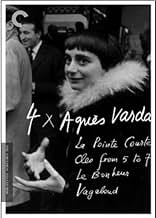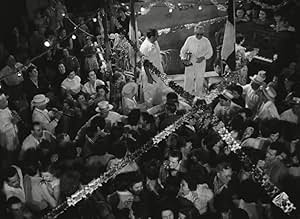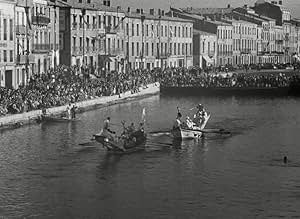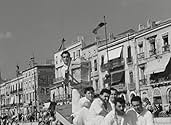NOTE IMDb
7,0/10
4,7 k
MA NOTE
Ce film comporte deux parties: des tranches de vie dans le village de pêcheurs de La Pointe Courte (la visite d'un inspecteur du gouvernement, la mort d'un enfant) et celles d'un couple géra... Tout lireCe film comporte deux parties: des tranches de vie dans le village de pêcheurs de La Pointe Courte (la visite d'un inspecteur du gouvernement, la mort d'un enfant) et celles d'un couple gérant leur relation changeante.Ce film comporte deux parties: des tranches de vie dans le village de pêcheurs de La Pointe Courte (la visite d'un inspecteur du gouvernement, la mort d'un enfant) et celles d'un couple gérant leur relation changeante.
Avis à la une
Agnès Varda began her career in 1954 as a feature film director with this movie that tells two separate stories in reciprocal counterpoint: daily life at a fishing village near Sète in France with its joys and dramatic moments and the relationship between husband and wife when she who is a Parisian returns to him after he had chosen to return to his birthplace where he feels now very happy but that doesn't seem to please her very much at first and puts their marriage in danger. This situation is given in a series of soft dialogues between them which don't reveal themselves deep and meaningful enough to make us feel the sentiments behind them. Varda has done much better later with such very good movies like "Le Bonheur" or "Cléo de 5 à 7". However this movie is also classified as a landmark in the New Wave of French cinema that began about that time with names like Truffaut, Godard and Chabrol. It's this historical value that mainly makes this movie worth to be seen.
10Red-125
La Pointe Courte (1955) was shown in the U.S. with its original French title. It was written and directed by Agnès Varda.
Although this was Varda's first film, she already had the uncanny knack of knowing how to film intensely personal moments, how to film small group discussions, and how to film crowd scenes. She wanted to write about the village of La Pointe Courte, but instead decided to make a movie. She borrowed money, and she made this movie. Clearly, she was a genius, and we can see that when we watch to film.
The acting in the film was at a high level. Most of the actors were nonprofessionals, who lived in the fishing village of La Pointe Courte.
However, the two leads: Philippe Noiret as Lui, and Silvia Monfort as Elle, were professional actors. (Although Noiret went on to become one of France's most popular actors, this was his first major role. Monfort was a professional who, by 1955, had already worked in theater and cinema.)
What makes the movie unique is that it blended one plot--an ethnographic vision of the small fishing village--with another very personal plot. In the latter plot, Noiret and Monfort play a married couple who have come from Paris to La Pointe Courte, where the husband was born. They are having an existential crisis. That always sounds pretentious, but I really think it fits in this case. Husband and wife are questioning their nature as individual human beings, their relationship as a couple, and whether they still truly love each other.
They rent a room in La Pointe Courte, and then they talk. (Remember, this is a French film--an early example of what became the French Cinematic New Wave . That means the couple don't kiss, they don't make love, they don't fish or swim--they talk about their relationship.)
Meanwhile, on the ethnographic side of the film, the people live hardscrabble lives because their income depends on the uncertainties of fishing. They are in a constant cat-and-mouse game with the public health authorities and the police, because they sometimes fish in contaminated water. As one character says, "Yes, the water is contaminated, but I haven't heard of anyone dying because they ate our fish."
The good news is that the villagers help one another. It's clearly a cooperative situation, and that's how they survive. However, their life is hard, and they're always one step away from disaster.
Philippe Noiret, even as a young man of 25, gives us the first view of the talent that he developed over the years. Monfort was his equal as an actor. She was 32 when the film was completed, but looked no older than Noiret. She had an unusual beauty, unlike the perfect beauty of Catherine Deneuve. In fact, Monfort looks like an actor Ingmar Bergman would have chosen to star in one of his films.
People have pointed out that some of the shots in La Pointe Courte resemble Ingmar Bergman's work. The fact is that Bergman's film Persona, which clearly has some similar shots, was completed in 1966, 11 years after Varda's film. My compliments to Bergman, who had the genius to recognize greatness in another director.
In many ways, the French Cinematic New Wave was a cooperative enterprise. The great director Alain Resnais was the editor of La Pointe Courte. Resnais had trained as an editor, but was already directing his own films in 1955. We can't tell how much his expertise helped fledgling filmmaker Varda, but my guess would be that his contribution was substantial.
We saw this film as part of an Agnès Varda retrospective in the wonderful Dryden Theatre at George Eastman House in Rochester, NY. It would be better to see it on the large screen. However, if that's not an option, see it on the small screen. This film is both an aesthetic pleasure and a movie of historical importance. If you love cinema, this film is a must!
Although this was Varda's first film, she already had the uncanny knack of knowing how to film intensely personal moments, how to film small group discussions, and how to film crowd scenes. She wanted to write about the village of La Pointe Courte, but instead decided to make a movie. She borrowed money, and she made this movie. Clearly, she was a genius, and we can see that when we watch to film.
The acting in the film was at a high level. Most of the actors were nonprofessionals, who lived in the fishing village of La Pointe Courte.
However, the two leads: Philippe Noiret as Lui, and Silvia Monfort as Elle, were professional actors. (Although Noiret went on to become one of France's most popular actors, this was his first major role. Monfort was a professional who, by 1955, had already worked in theater and cinema.)
What makes the movie unique is that it blended one plot--an ethnographic vision of the small fishing village--with another very personal plot. In the latter plot, Noiret and Monfort play a married couple who have come from Paris to La Pointe Courte, where the husband was born. They are having an existential crisis. That always sounds pretentious, but I really think it fits in this case. Husband and wife are questioning their nature as individual human beings, their relationship as a couple, and whether they still truly love each other.
They rent a room in La Pointe Courte, and then they talk. (Remember, this is a French film--an early example of what became the French Cinematic New Wave . That means the couple don't kiss, they don't make love, they don't fish or swim--they talk about their relationship.)
Meanwhile, on the ethnographic side of the film, the people live hardscrabble lives because their income depends on the uncertainties of fishing. They are in a constant cat-and-mouse game with the public health authorities and the police, because they sometimes fish in contaminated water. As one character says, "Yes, the water is contaminated, but I haven't heard of anyone dying because they ate our fish."
The good news is that the villagers help one another. It's clearly a cooperative situation, and that's how they survive. However, their life is hard, and they're always one step away from disaster.
Philippe Noiret, even as a young man of 25, gives us the first view of the talent that he developed over the years. Monfort was his equal as an actor. She was 32 when the film was completed, but looked no older than Noiret. She had an unusual beauty, unlike the perfect beauty of Catherine Deneuve. In fact, Monfort looks like an actor Ingmar Bergman would have chosen to star in one of his films.
People have pointed out that some of the shots in La Pointe Courte resemble Ingmar Bergman's work. The fact is that Bergman's film Persona, which clearly has some similar shots, was completed in 1966, 11 years after Varda's film. My compliments to Bergman, who had the genius to recognize greatness in another director.
In many ways, the French Cinematic New Wave was a cooperative enterprise. The great director Alain Resnais was the editor of La Pointe Courte. Resnais had trained as an editor, but was already directing his own films in 1955. We can't tell how much his expertise helped fledgling filmmaker Varda, but my guess would be that his contribution was substantial.
We saw this film as part of an Agnès Varda retrospective in the wonderful Dryden Theatre at George Eastman House in Rochester, NY. It would be better to see it on the large screen. However, if that's not an option, see it on the small screen. This film is both an aesthetic pleasure and a movie of historical importance. If you love cinema, this film is a must!
"The first tributary of its narrative bifurcation is an ethnological essay exploring the daily hurdles and weekend divertissements of the local folks, their livelihood (contending with policemen for fishing in an illegal lagoon nearby), their grief (mortality is high among a philoprogenitive household), their earthly concerns (a 16-year-old girl seeks the approval of her father for courtship), and their unalloyed joy (a jubilant aquatic jousting competition and its attendant festa are faithfully recorded with both intimacy and grandeur), all are enlivened through Varda's unobtrusive regard and well-posited lens."
read my full review on my blog: cinema omnivore, thanks
read my full review on my blog: cinema omnivore, thanks
Agnes Varda never got her just due for having made the first true film of the French New Wave. Part of it was because this picture didn't get much play at the time - even in France, but, a larger factor was that she wasn't as tight with the Truffuat and Godard Cahiers du Cinema clique who also got the first wide attention with films like 400 BLOWS and BREATHLESS. And, oh yes, she was a woman.
History aside, Varda's debut feature displays attributes associated with the Nouvelle Vague so prominently, that it is indeed a shame that she isn't properly credited.
The low budget shooting on the run, the elliptical dialogue between the lead couple (Philippe Noiret and Silvia Monfort) and the often off-kilter stylish compositions and editing. The score is largely a droning clarinet. It's all there in LA POINTE COURTE.
Varda's interest in photography which led to her career-long interest in Documentary filmmaking also marks the film, for the central romance shares time equally with a portrait of the tiny fishing community where it's set (the Noiret character's hometown). The ambitions of the film are small, but, it's still quite a low key delight. It should be better known and recognized as the true start of that famous French filmmaking Revolution.
Highlights:
Lowlights:
- Visually often very beautiful.
- The exploration into marriage and what happens to a relationship after the initial thrill, discovery, and romance phase transitions into less pyrotechnics, and just knowing the other person almost as a part of yourself. The woman (Silvia Monfort) misses what she once had, whereas her husband (Philippe Noiret) is more content, and the two talk about it in very honest ways.
- The film seems to be right at the nexus of Italian neorealism and the French New Wave, with interesting aspects of each. It shows us the world of these (real) working class fishermen with their homes filled with kids, and does so with the flair of creative technique. Hooray it was made by a woman director, Agnès Varda.
- Loved the jousting scenes in the canal.
- Also loved the black cat doing an impromptu stretch in the background of one scene, effectively stealing it from the couple.
Lowlights:
- The story is lacking. There's a point in putting the cultural traditions of the fishing villagers and their occasional struggles with life side by side with this couple's difficulties in the cultural tradition of marriage, but the connective tissue is tenuous, and there isn't a lot going on here that's truly compelling.
- While the marital conflict is interesting and the dialogue explores it reasonably well, the way the actors deliver their discussion is so passionless it's as if they were sleepwalking through their roles. I believe it's meant to reflect the state their relationship has gotten to, but I think it was carried a little too far.
- The score is weirdly jaunty, and it's awful. It's almost as if the newness of the film style made figuring out what type of music would go with it a mystery, either that or it was an attempt to breathe life into what is a pretty quiet film. Either way, it doesn't work.
- Did we need the shot of the dead cat?
Le saviez-vous
- AnecdotesThis film is considered by many critics as the starting point of the French New Wave film movement.
- GaffesThe entire movie has been shot without sound and dubbed later, and it shows. At several points in the movie, the dialogue does not match the lip movements at all. For instance, early in the movie, when Jules' wife tells the other woman that it was Jules who scared the inspectors.
- ConnexionsFeatured in Great Directors (2009)
Meilleurs choix
Connectez-vous pour évaluer et suivre la liste de favoris afin de recevoir des recommandations personnalisées
- How long is La Pointe Courte?Alimenté par Alexa
Détails
Box-office
- Montant brut mondial
- 1 596 $US
- Durée1 heure 21 minutes
- Couleur
- Mixage
- Rapport de forme
- 1.37 : 1
Contribuer à cette page
Suggérer une modification ou ajouter du contenu manquant























